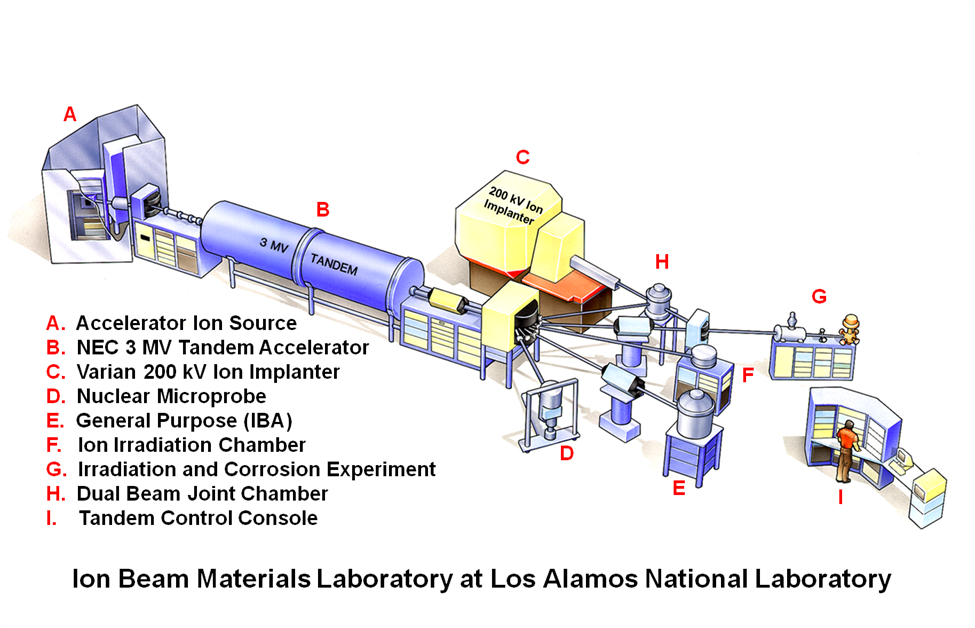
The 6,000 sq. ft. facility hosts several accelerators, sample preparation lab space, a meeting space with remote conference AV equipment, and a kitchen.
Major materials research areas include:
- Radiation damage through ion irradiation: Energetic ion beams transfer their kinetic energies to lattice atoms through elastic collisions and generate displaced atoms (interstitials) and vacancies. Evolution of these point defects leads to the formation of extended defects including vacancy clusters, dislocation loops, voids, and other complex microstructural changes. For example, self-ion irradiation is used to accelerate radiation damage behavior in materials in lieu of neutrons from fission reactors and fusion devices.
- Radiolysis through ion irradiation: Energetic light ion beams transfer their kinetic energies to electrons through inelastic scattering and generate excited/ionized electrons. As a result, chemical bonds can be broken to form new species (radiolytic products) in polymers or to create color centers in insulators. For example, high energy protons can produce similar degradation to polymers as electrons and gamma ray exposures but at accelerated damage rates.
- Materials modification through ion implantation: Introduce virtually any chemical species in host materials beyond thermodynamically controlled physical and chemical processes. Exact dopant type, location and concentration are all well-defined. Post-implantation thermal annealing is often needed to activate dopants by removing the lattice damage. For example, implanting boron (phosphorus) dopants in silicon is routinely used to produce p-type (n-type) devices in semiconductors for microelectronics applications.
- Materials characterization through ion beam analysis: A collection of characterization techniques used to analyze a material’s elemental composition and defect information through ion channeling in single crystal targets. Rutherford backscattering spectrometry (RBS), the most quantitative surface analysis technique. Elastic recoil detection (ERD) — complementary to RBS and more sensitive to light elements measurements. Nuclear reaction analysis (NRA) — complementary to RBS and very sensitive to specific isotopes of light elements measurements. For example, hydrogen depth profiling by NRA provides unparalleled depth resolution, sensitivity, and accuracy as compared with many other techniques. Particle-induced x-ray emission (PIXE) — a very sensitive spectroscopy method used to measure impurities in targets.
Capabilities include:
- Four accelerators with 8 beamlines/endstations dedicated to varying research needs and applications. Most target chambers offer target temperatures of -190°C–900°C.
- NEC 3 MV Pelletron Tandem Accelerator:
- Two ion sources (RF plasma and SNICS-II) and five beamlines/endstations designed for customized research needs. Ion species ranges from H to Au depending on negative ion production efficiency through Cs ion sputtering. Ion beam energies as high as 6 MeV for protons, 9 MeV for alphas, and up to 27 MeV for heavy ions with reduced beam currents. Low energy boundary ~400 keV, 200 keV has been used with a reduced beam current.
- L15 Beamline for high temperature ion irradiation, coupled irradiation and corrosion experiments (ICE) with defocused beams. Neutron and gamma radiation shield is in place at the target chamber for high energy and high current proton beam irradiations.
- L30 Beamline for Tribeam chamber (Tandem beam + Varian beam + Plasma exposure) for plasma-facing fusion materials research (under development).
- L45 Beamline for coupled self-ion irradiation from Tandem and He implantation from Varian Implanter. A 22Na positron beam is coupled to the Dual-Beam chamber to perform in-situ irradiation defects measurement using positron annihilation spectroscopy (PAS)(under development).
- R15 Beamline for general purpose Ion Beam Analysis (RBS, ERD, NRA, PIXE). A new target chamber with a full suite of ion beam analysis capability including the automated computer control for ion channeling will replace the old chamber in later 2023.
- R30 Beamline for alpha beam radiolysis (i.e. an energy and intensity tunable alpha source with an on/off switch) and high energy ion irradiation/implantation with a larger rastering beam.
- Danfysik 200 kV Research Ion Implanter
- Performs the majority of ion irradiation and implantation experiments below 400 keV energy region.
- Powerful Tri-mode ion source (Gas/Oven/Sputter) allows production of virtually any ion species in the periodic table. Some of them can be multiple charge states that lead to higher than 200 keV ion beam possible (e.g., 800 keV Kr or Xe for low level radiation damage or impurity doping). As low as 20 keV has been used for low fluence experiments.
- A second beamline and endstation is being developed to support 800 keV fission gas transport research in nuclear fuels with a higher fluence (~1E16 ions/cm2) and higher temperature (~1250 C)
- Varian 200 kV Production Ion Implanter
- Freeman ion source to produce sharp focused beam from gas species as well as low melting elements. The implanter may be used standalone for radiation damage or chemical doping, or be coupled with beams from Tandem, Positron source, or Plasma gun for special ion irradiation configurations.
- Low Energy Coultron Ion Implanter
- Custom-built low energy system based on the established Coultron ion source with operational beam energy 20 eV–20 keV for most gas species and select metal ions. Once fully developed, it is expected to cover lower beam energies that the Tandem and the Implanters cannot reach effectively. Doping of 2D materials with ultralow energy impurities to tailor their optoelectronic properties (under development).
Contact: Yongqiang Wang
